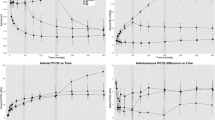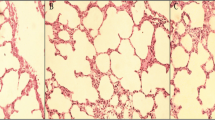Abstract
Purpose
The hypothesis of our study is that during anesthesia, administration of 80 % oxygen concentration increases oxidative stress more than 40 % oxygen.
Methods
Forty ASA I-II patients were included in a randomized, single-blind study. Expiratory tidal volumes (ETV) were measured before induction and after extubation. After ventilation with 0.8 FiO2 and intubation, mini-bronchoalveolar lavage (mini-BAL), arterial blood gas (ABG), and blood samples were taken. Patients were randomly assigned to receive 0.8 (group I) or 0.4 (group II) FiO2 during management. Before extubation, mini-BAL, ABG, blood samples were taken. PaO2/FiO2, lactate, malondialdehyde (MDA), protein carbonyl (PCO), superoxide dismutase (SOD), total sulfhydryl (T-SH), non-protein sulfhydryl (NPSH), and protein sulfhydryl (PSH) were measured. In both groups, mean arterial pressure and heart rate values were recorded with 30-min intervals.
Results
ETV values were higher in group II after extubation. PaO2/FiO2 values were higher in group II after extubation compared to group I. In both groups, plasma PCO, SOD, and T-SH levels increased significantly before extubation, whereas the increase in MDA was not significant between groups. Plasma PCO, T-SH, and lactate levels were higher in group I, and plasma SOD, and PSH were higher in group I before extubation. In both groups, MDA, SOD, T-SH, and NPSH levels in mini-BAL increased significantly before extubation. Between-group comparisons, PCO, T-SH, PSH, and NPSH were significantly higher in the BAL samples of group II, and MDA levels were higher in group I.
Conclusions
We found that 80 % FiO2 decreased ETV and PaO2/FiO2 and increased lactate levels and oxidative stress more, inhibiting antioxidant response compared to 40 % FiO2.


Similar content being viewed by others
References
Qadan M, Akca O, Mahid S, Hornung C, Polk CH. Perioperative supplemental oxygen therapy and surgical site infection. A meta-analysis of randomized controlled trials. Arch Surg. 2009;144:359–66.
Havaguimian F, Iysakowski C, Elia N, Tramer MR. Effect of intraoperative high inspired oxygen fraction on surgical site infection, postoperative nausea, and vomiting, and pulmonary function. Systematic review and meta-analysis of randomized controlled trials. Anesthesiology. 2013;119:303–16.
Klingel ML, Patel SV. A meta-analysis of the effect of inspired oxygen concentration on the incidence of surgical site infection following cesarean section. Int J Obstet Anesth. 2013;22:104–12.
Edmark L, Kostava-Ahendan K, Endlund M, Hedenstiesna G. Optimal oxygen concentration during induction of general anesthesia. Anesthesiology. 2003;1:28–33.
Habre W, Petak F. Perioperative use of oxygen: variabilities across age. Br J Anaesth. 2014;113 (S2):ii26–36.
Rothen HU, Sparre B, Engberg G, Wegenius G, Rebert A, Hedenstiesna G. Prevention of atelectasis during general anesthesia. Lancet. 1995;345:1387–91.
Edmark L, Auner U, Enlund M, Ostberg E, Hedenstierna G. Oxygen concentration and characteristics of progressive atelectasis formation during anesthesia. Acta Anaesthesiol Scand. 2011;55:75–81.
Machado HS, Nunes CS, Sa P, Couceiro A, da Silva AM, Aquas A. Increased lung inflammation with oxygen supplementation in tracheotomized spontaneously rabbits: an experimental prospective randomized study. BMC Anesthesiol. 2014;14:86.
Martin DS, Grocott MPW. Oxygen therapy in anaesthesia. Br J Anaesth. 2013;111:867–71.
Koksal GM. Oxidative stress and its complications in human health. Adv Biosci Biotechnol. 2012;3:1113–5.
Sies H. Strategies of antioxidant defense. Eur J Biochem. 1993;215:213–9.
Koksal GM, Sayilgan C, Aydin S, Oz H, Uzun H. Correlation of plasma and tissue oxidative stress in intraabdominal sepsis. J Surg Res. 2004;122:180–3.
Auten R, Davis JM. Oxygen toxicity and reactive oxygen species: the devil is in the details. Pediatr Res. 2009;66:121–7.
Davey AJ, Diba A. Measurements of pressure and gas flow. In: Beatty P, editor. Chapter 4, Ward’s anaesthetic equipment, 5th edn. Elsevier Saunders, 2005, pp. 51–64. ISBN 141.602558.
Koksal GM, Sayilgan C, Aydin S, Oz H, Uzun H. The effects of sevoflurane and desflurane on lipid peroxidation during laparoscopic cholecystectomy. Eur J Anaesthesiol. 2004;21:217–20.
Wong CH, Liu TZ, Chye SM, Lu FJ, Liu YC, Lin ZC, Chen CH. Sevoflurane-induced oxidative stress and cellular injury in human peripheral polymorphonuclear neutrophils. Food Chem Toxicol. 2006;44:1399–407.
Sun Y, Oberley LW, Li Y. A simple method for clinical assay of superoxide dismutase. Clin Chem. 1988;34(3):497–500.
Reznick AZ, Packer L. Oxidative damage to proteins: spectrophotometric method for carbonyl assay. Methods Enzymol. 1994;233:357–63.
Witko V, Nguyen AT, Descemps-Latscha B. Microtiter plate assay for phagocyte-derived taurine-chloramines. J Clin Lab Anal. 1992;6:47–53.
Sedlak J, Lindsay RH. Estimation of total, protein-bound, and nonprotein sulfhydryl groups in tissue with Ellman’s reagent. Anal Biochem. 1968;25:192–205.
Hu ML. Measurements of protein thiol groups and glutathione in plasma. Methods Enzmol. 1994;233:381–5.
Reuter S, Gupta CS, Chaturvedi MM, Aggarwal BB. Oxidative stress, inflammation, and cancer: how are they linked? Free Radic Med. 2010;49:1603–16.
Pelicano H, Carney D, Huang P. ROS stress in cancer cells and therapeutic implications. Drug Resist Updates. 2004;7:97–110.
Ladha K, Vidal Melo MF, McLean DJ, Wanderer JP, Grabitz SD, Kurth T, Eikermann M. Intraoperative protective mechanical ventilation and risk of postoperative respiratory complications: hospital based registry study. BMJ. 2015; 351:h3646. doi:10.1136/bmj.h3646.
Güldner A, Kiss T, Serpa Neto A, Hemmes SN, Canet J, Spieth PM, Rocco PR, Schultz MJ, Pelosi P, Gama de Abreu M. Intraoperative protective mechanical ventilation for prevention of postoperative pulmonary complications: a comprehensive review of the role of tidal volume, positive end-expiratory pressure, and lung recruitment maneuvers. Anesthesiology. 2015;123(3):692–713. doi:10.1097/ALN.0000000000000754.
Hedenstierna G, Edmark L, Perchiazzi G. Postoperative lung complications: have multicentre studies been of any help? Br J Anaesth. 2015;114:541–3.
Martin D, Grocott MP. Oxygen therapy and anaesthesia: to much of a good thing? Anaesthesia. 2015;70:522–7.
Mc Quaid KE, Keenan AK. Physiological society symposium impaired endothelial and smooth muscle cell function in oxidative stress. Exp Physiol. 1997;82:269–376.
Branson RD, Robinson BR. Oxygen: when is more the enemy of good? Intens Care Med. 2011;37:1–3.
Andreoli TE. Free radicals and oxidative stress. Am J Med. 2000;108:650–1.
Uzun D, Korkmaz GG, Sitar ME, Cebe T, Yanar K, Cakatay U, Aydın S. Oxidative damage parameters in renal tissues of aged and young rats based on gender. Clin Interv Aging. 2013;8:809–15.
Acknowledgments
No financial support and funding were used. No commercial or non-commercial affiliations exits.
Author information
Authors and Affiliations
Corresponding author
Ethics declarations
Conflict of interest
The author(s) declare that they have no competing interests.
About this article
Cite this article
Koksal, G.M., Dikmen, Y., Erbabacan, E. et al. Hyperoxic oxidative stress during abdominal surgery: a randomized trial. J Anesth 30, 610–619 (2016). https://doi.org/10.1007/s00540-016-2164-7
Received:
Accepted:
Published:
Issue Date:
DOI: https://doi.org/10.1007/s00540-016-2164-7




